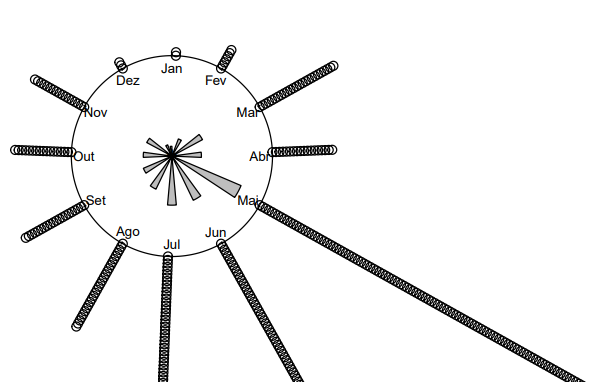Modeling dengue cases in the city of Campina Grande-PB using circular statistics
Keywords:
Directional Statistics, Circular Data, ArbovirusesAbstract
This work proposes the use of circular statistics to model the number of monthly dengue cases in the city of Campina Grande-PB. Circle statistics is used for data that can be represented as points on the circumference of the unit circle. What sets this approach apart from the commonly used approach is that it respects the nature of the data and provides techniques and graphs that highlight the intrinsic characteristics of directional variables. The main difference of this approach is that the data is represented by angles, which highlights the periodic nature of the data. The data used in this work refer to the number of dengue cases notified monthly in the municipality of Campina Grande and were made available by SINAN through the TABENET (Public domain tabulator developed by DATASUS that allows organizing data to generate information from databases of data from the unified health system, it is possible to generate tables and produce graphs and maps).
The period considered goes from January 2018 to December 2021. The statistical procedures were performed in software R. For the analyzes the packages dplyr and Circular were used.
References
BRUNSDON, C.; CORCORAN, J. Using circular statistics to analyse time patterns in crime
incidence. Computers, Environment and Urban Systems, v. 30, p. 300–319, 2006.
FISHER. Dispersion on a sphere, proc. r. In: Soc. London. [S.l.: s.n.], 1953. v. 17.
FISHER, N. I. Statistical analysis of circular data. [S.l.]: cambridge university press, 1995.
GOIS, J. E. S. Contribui ̧c ̃ao dos modelos estoc ́asticos para o estudo da climatologia urbana. ́
JAMMALAMADAKA, S. R.; SENGUPTA, A. Topics in circular statistics. [S.l.]: world
scientific, 2001. v. 5.
LANDLER, L.; RUXTON, G. D.; MALKEMPER, E. P. Circular data in biology: advice for
effectively implementing statistical procedures. Behavioral Ecology and Sociobiology, v. 72,
n. 128, 2018.
MAGALHAES, M. N.; LIMA, A. C. P. D. Noções de probabilidade e estatística. [S.l.]: Editora
da Universidade de S ̃ao Paulo, 2015. v. 7.
MARDIA, K. V.; JUPP. Directional statistics. [S.l.]: Wiley Online Library, 2000. v. 2.
MAYA-MANZANO, J.; SADYS, M.; TORMO-MOLINA, R.; FERNÁNDEZ-RODRÍGUEZ, S.;
OTEROS, J.; SILVA-PALACIOS, I.; GONZALO-GARIJO, A. Relationships between airborne
pollen grains, wind direction and land cover using gis and circular statistics. Science of the
Total Environment, v. 584–585, p. 603–613, 2017.
PEWSEY. Circular statistics in R. [S.l.]: Oxford University Press, 2013.
R CORE TEAM. R: A Language and Environment for Statistical Computing. Vienna, Austria,
Dispon ́ıvel em: ⟨http://www.R-project.org/⟩.
RAYLEIGH, L. On the resultant of a large number of vibrations of the same pitch and of
arbitrary phase. The London, Edinburgh, and Dublin Philosophical Magazine and Journal of
Science, Taylor & Francis, v. 10, n. 60, p. 73–78, 1880.
WATSON, G. S.; WILLIAMS, E. J. On the construction of significance tests on the circle and
the sphere. Biometrika, JSTOR, v. 43, n. 3/4, p. 344–352, 1956.

Downloads
Published
How to Cite
Issue
Section
License
Proposta de Política para Periódicos de Acesso Livre
Autores que publicam nesta revista concordam com os seguintes termos:
- Autores mantém os direitos autorais e concedem à revista o direito de primeira publicação, com o trabalho simultaneamente licenciado sob a Licença Creative Commons Attribution que permite o compartilhamento do trabalho com reconhecimento da autoria e publicação inicial nesta revista.
- Autores têm autorização para assumir contratos adicionais separadamente, para distribuição não-exclusiva da versão do trabalho publicada nesta revista (ex.: publicar em repositório institucional ou como capítulo de livro), com reconhecimento de autoria e publicação inicial nesta revista.
- Autores têm permissão e são estimulados a publicar e distribuir seu trabalho online (ex.: em repositórios institucionais ou na sua página pessoal) a qualquer ponto antes ou durante o processo editorial, já que isso pode gerar alterações produtivas, bem como aumentar o impacto e a citação do trabalho publicado (Veja O Efeito do Acesso Livre).
